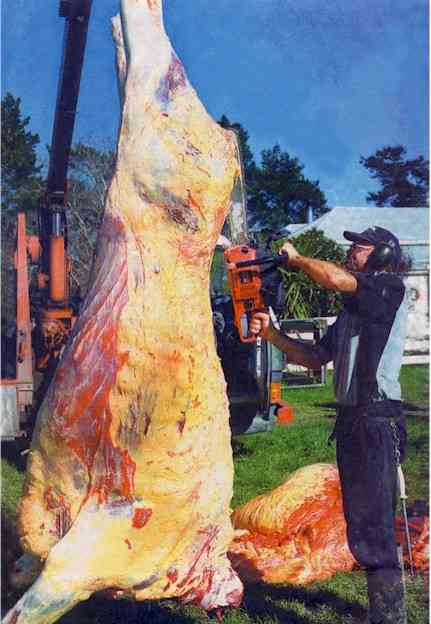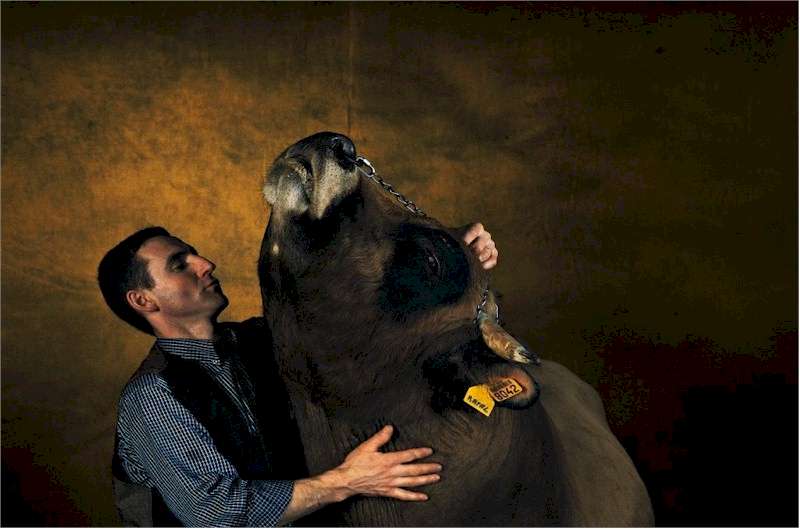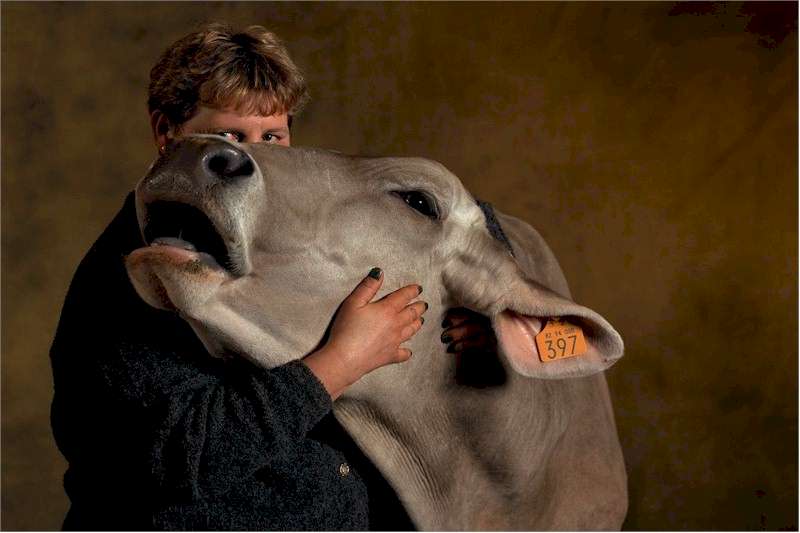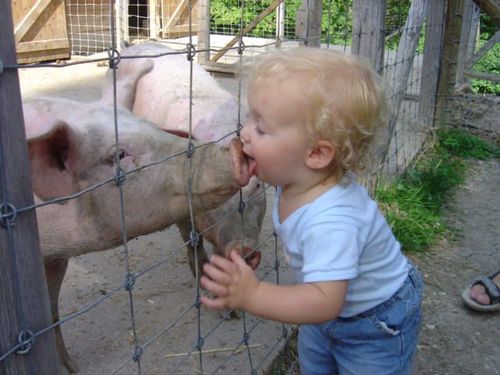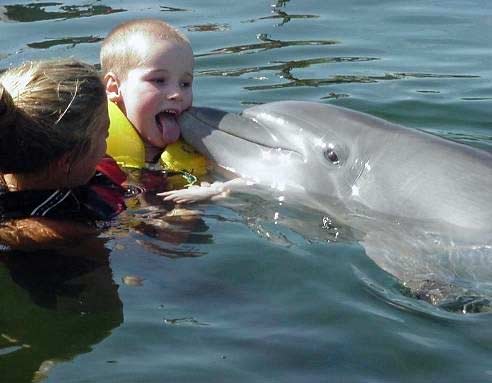Someone's Got to Do It?
Bloody Hard WorkIt is not from the benevolence of the butcher, the brewer, or the baker that we expect our dinner, - Adam Smith
Slaughterman Wayne Evans: "You'd never get rich but by Helen Bain His weapons include guns, knives and an electric fence and he slaughters up to six victims a day. Here is a man who makes his living out of killing. "Hang on a minute, I'm right in the middle of killing a pig," says Carterton slaughterman Wayne Evans when I ring him on his cellphone. It's a response you're quite likely to get when you call Mr Evans, because he does a lot of killing. A butcher by trade since 1974, Mr Evans became sick of the routine of 5am starts and serving customers, so sold his half of the shop and went into farm killing. He kills cattle, sheep, deer, goats, pigs - even ostriches. "I'm not in a hurry to do them again. You have to grab them by the neck and shake them around till they go floppy and fall down unconscious, then you have to stick them in the chest quickly before they get up again. They boot you around quite a bit - and then you have to pluck them," he remembers. "There's a lot of feathers on an ostrich." Killing is skilled work, Mr Evans says. His partner in the butcher shop showed him the basics of the job, and he learned more from old slaughtermen at the freezing works, which is where, as a teenager, he began his career in butchery. Knowing how to use and sharpen knives properly is also an art, and he wouldn't advise amateurs to attempt to slaughter livestock. "Cattle used to take me an hour and a half - now I can do it in half an hour," he says. "That's how long it takes to pop it, skin it, quarter it, gut it and weigh it." At 42, Mr Evans says the physical nature of the work can be tough - six cattle a day is about as much as he can handle. "It's getting pretty hard on the old body - it's hard yakka all right. It's not too good after a night on the booze." And his "clientele" don't always go gently into that good night - once a ram headbutted him, and he has copped a few hooves in tender parts of his anatomy. But Mr Evans says farm killing is much less stressful on livestock than taking them to an abattoir to have them killed. Abattoir killing involves herding the stock on to trucks - usually with the aid of electric cattle prods - trucking them long distances, then unloading them into yards where the smell of blood from the animals already killed "sends them ballistic". His technique involves approaching the unsuspecting beast in its paddock and shooting it with a .22 between the ears and the eyes. That usually drops the animal instantly, but it's important to get the right spot: too low and cattle have been known to get up again once they've been "popped". Next, Mr Evans cuts the animal's throat, and connects it to an electric fence unit. "It's got about 9,500 volts and you whack her on full blast for about 5 minutes. The legs kick up in the air and it pumps all the blood out." He then puts blocks on either side of the animal, with its feet pointing skyward. He skins one side, then rolls it over and does the other. He hoists it up by the back legs using the crane on his truck, finishes skinning it and guts it. Getting rid of the guts is the farmers' responsibility. Mr Evans keeps the hide - which varies in value from $22-$70, depending on quality. He charges an average of $35 plus the hide to slaughter cattle, less for smaller animals, and more if he has to travel long distances to remote parts of Wairarapa. In a good week, he can clear $800 after expenses, but the amount of work varies considerably according to the season. When farmers are busy with lambing and calving, killing work is scarce and can bring in as little as $100 a week. "You'd never get rich doing it, but it's a good job and I can take a day off whenever I like," Mr Evans says. Travelling around the beautiful Wairarapa countryside and meeting different people every day is also an attraction of the job, he says. The fact that he kills things for a living doesn't worry him at all - it is not something he even stops to think about. "I've got three kids, two of them at high school. You can't look at things like that - you've just got to get on with the job." And Mr Evans has no hesitation in making a meal out of meat he has quite recently seen walking around in a paddock. "When I was younger, I didn't like meat much, but working at the butchers, they ate meat even for breakfast, so I had to get to like it really."
Trade SecretsTHE JOB: Slaughterman Wayne Evans. Source: The Dominion Monday 8 January 2001; photo credit Haana Howard
Why is it okay for Wayne Evans to kill and not give it a thought? Because he has 3 kids. On the previous page (in Good Will Hunting), Lee Davis, rode a horse into the bush to kill a pig because he loved "bacon for breakfast and pork chops for tea." Yet he did not eat the pig he killed - but that's okay, because he gave it to the farmer's kids. Kids are a convenient excuse for causing death. Wars are also fought for kids' sake...
Scenes from the Abattoirby Nicola Kriek SIR, - I read with interest your feature (8 January) in which you showcased the work of slaughterman Wayne Evans. No doubt many of your readers found the article unpleasant (as did I) and are grateful that they do not have to make a living out of killing animals. In my job as education officer at Wellington SPCA, I spend my days promoting a caring and compassionate attitude toward animals. Your article illustrated to me the up-hill battle I face when attempting to change attitudes toward animals, as our society condones the often cruel slaughter of well over 200,000 animals each day for human consumption. The suffering of these animals is undeniable. On a recent visit to an abattoir I saw the terror, misery and abuse experienced by the animals waiting to be killed and in the process of being killed. Those scenes will never leave me. If we are truly committed to creating a world where violence and unnecessary suffering are not accepted, we must take a good hard look at the way we treat those who cannot defend themselves against us. The choice is ours, we can choose to kill animals and eat their flesh, or we can choose a more compassionate, peaceful path. Animal abuse stems from passive attitudes and choices. It is time to recognise animals as sentient beings who are not for us to exploit. Nichola Kriek Source: The Dominion Wednesday 24 January 2001
As a vegetarian, I have great sympathy for the view expressed above. However, life isn't that simple. Could those 200,000 animals slaughtered each day be turned out into a large fenced area for hunters to track and kill? (See Hunting.) Perhaps any animal still alive after a week is "retired" and allowed to live, with food paid for by the hunters' fees? (The same could be true for the hundreds of thousands of unwanted pets "put down" around the world - plus they could also be eaten: see Yummy Dog and Bon Appetit elsewhere in this section.) Or what if the slaughtering were made totally painless? (See Sedative Reduce Stress and Dying for a Steak for examples.) Then there's the problem of unwanted pests - many of whom, like rabbits and opossums in New Zealand (see Possum Pancake further along in this section) were "introduced" into alien habitats where no predators controlled their numbers; they are now destroying unique ecosystems. Should they be "fair game"? Of course, in some parts of the world too many people are also destroying ecosystems. Will we someday have open season on the poor with the ones left alive after a week given jobs or an income for life? On one hand, you have excess protein being produced. On the other hand, you have people who want to eat meat and people who want to eat anything. It's silly to assume, in the name of fairness to animals, that people will be allowed to starve. (Animals DO eat each other, after all.) And, once a foot has been placed on that particular slippery slope, then meat lovers will also be accommodated. And hunters. I think attention and resources would be better spent making animals' lives as pleasant as possible and their deaths as painless and stress-free as possible. What happens to their bodies after death is a different issue entirely.
Vegetarian Diet Kills Animals Tooby Lee Dye Steven Davis says he didn't set out to start a fight, but found one when he began attacking one of the most sacred beliefs of the vegetarian community. One of the reasons most commonly cited by vegetarians for giving up meat is the conviction that other animals have a right to life as well as humans. But when Davis began setting up a course on animal ethics for the animal science department at Oregon State University four years ago, he reached a rather surprising conclusion. Nobody's hands are free from the blood of other animals, not even vegetarians, he concluded. Millions of animals are killed every year, Davis says, to prepare land for growing crops, "like corn, soybean, wheat and barley, the staples of a vegan diet." The animals in this case are mice and moles and rabbits and other creatures that are run over by tractors, or lose their habitat to make way for farming, so they are not as "visible" as cattle, he says. And that, Davis says, gives rise to a fundamental question: "What is it that makes it okay to kill animals of the field so that we can eat [vegetables or fruits] but not pigs or chickens or cows" Any disruption of the land, whether it be to farm or to build subdivisions, reduces the amount of land left for other animals, resulting in the deaths of many. And Davis, a professor of animal science at Oregon State who grew up on a farm, says as a child he saw animals killed by the routine operation of farm machinery, so there's no way to have a bloodless farm. "If they say they don't want to kill an animal so they can eat, I think their conclusion is misguided because they are killing animals so that they can eat that vegetarian diet," Davis says. "Those animals happen to be a little bit invisible. They are not as obvious to the man on the street as killing a steer in the slaughterhouse. But nonetheless, it's still going on." Davis believes the death toll among all animals could be reduced if ranchers concentrated on raising cattle instead of pigs and chickens and let those cattle revert to foraging in open fields that could be shared with other animals. Citing US Department of Agriculture statistics, Davis says of the 8.4 billion animals killed each year for food in the United States, 8 billion are poultry and only 41 million are cows, calves, sheep and lambs. So he figures you could double the number of cattle killed each year, and lay off the chickens, and consequently save about 7.5 billion animals. But just letting cattle roam freely doesn't solve the problem because other animals like coyotes and wolves would still likely be killed. It might do more good if all of us just ate a little less of everything. Lee Dye is a former science writer for the Los Angeles Times who now lives in Juneau, Alaska. Source: abcnews.go.com © 2004 ABC News Internet Ventures
What Do You Think? Did These Cows Get Eaten?
"A little to the left, please..."
"Well, kiss me goodbye, then..."
"What?!? And all this time I thought you were my FRIEND!!" Source: www.yannarthusbertrand.com incredible livestock photos by Yann Arthus-Bertrand. Visit his site for some of the most stunning photos I have ever seen, of all kinds of things...
Baby, You Moo MeI am Cow, hear me moo. I am Cow, eating grass. I am Cow, Here I stand by the Arrogant Worms from their Gift Wrapped album (2002). Band members include: Trevor Strong (small BA) - Sings and plays any instrument smaller than three inches long. Prodigious mane of curly blonde locks. Not a crazed Muppet. Embarrassed to possess a psychology degree from Queen's. Spent his formative years in Belleville, ON, and will shake noticeably when you mention that fact. Chris Patterson (medium BA) - Play bass, sings and never stops moving. (Has lived in every town The Worms have ever played in.) Not the best bowler. But he can dance! Has been employed as a paperboy, grocery bagger, gas jockey and blacksmith. Loves his pal Lumpy. Hates pancreas. Mike McCormack (large MSc) - Plays guitar, sings and rants. Colour blind. Losing his hearing. (Explains both his fashion sense and taste in music...) Tallest, oldest, most educated. Best bowler in The Worms. Only watches tv if it's CFL, Hockey or Star Trek. Thinks Voyager would be better if either James Kirk or Shania Twain were captain. Source: festival.bc.ca (go there to buy their albums) or arrogant-worms.com (official website)
Having Pork for Lunch?
This is how they do it down on the farm.
"I'm Clean!"
We'd rather you didn't eat this one...
For more on animals, including reptiles, crustaceans, arachnids, insects, fish, birds, pets, livestock, rodents, bears, primates, whales and Wellington's waterfront, click
"Up" below to take you to the Table of Contents for this Animals section. |
 Animals
Animals Animation
Animation Art of Playing Cards
Art of Playing Cards Drugs
Drugs Education
Education Environment
Environment Flying
Flying History
History Humour
Humour Immigration
Immigration Info/Tech
Info/Tech Intellectual/Entertaining
Intellectual/Entertaining Lifestyles
Lifestyles Men
Men Money/Politics/Law
Money/Politics/Law New Jersey
New Jersey Odds and Oddities
Odds and Oddities Older & Under
Older & Under Photography
Photography Prisons
Prisons Relationships
Relationships Science
Science Social/Cultural
Social/Cultural Terrorism
Terrorism Wellington
Wellington Working
Working Zero Return Investment
Zero Return Investment